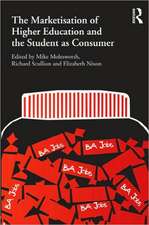Collaboration and Networking in Education
Autor Daniel Muijs, Mel Ainscow, Chris Chapman, Mel Westen Limba Engleză Paperback – 14 oct 2014
In this book, we aim to provide a theoretical background to educational collaboration, drawing on research and theory in policy studies, psychology and sociology, leading ultimately to a typology of networks. This theoretical base will be tested in the discussion of a number of case studies referring to specific initiatives such as the Federations programme, multi-agency collaboration and Networked Learning Communities. Lessons for practice will be drawn and presented in terms of factors internal and external to the school. The key issue of network leadership will be addressed here as well.
| Toate formatele și edițiile | Preț | Express |
|---|---|---|
| Paperback (1) | 635.31 lei 6-8 săpt. | |
| SPRINGER NETHERLANDS – 14 oct 2014 | 635.31 lei 6-8 săpt. | |
| Hardback (1) | 641.53 lei 6-8 săpt. | |
| SPRINGER NETHERLANDS – 7 ian 2011 | 641.53 lei 6-8 săpt. |
Preț: 635.31 lei
Preț vechi: 747.43 lei
-15% Nou
Puncte Express: 953
Preț estimativ în valută:
121.58€ • 132.02$ • 102.13£
121.58€ • 132.02$ • 102.13£
Carte tipărită la comandă
Livrare economică 22 aprilie-06 mai
Preluare comenzi: 021 569.72.76
Specificații
ISBN-13: 9789400789821
ISBN-10: 9400789823
Pagini: 192
Ilustrații: VIII, 183 p.
Dimensiuni: 155 x 235 x 10 mm
Greutate: 0.28 kg
Ediția:2011
Editura: SPRINGER NETHERLANDS
Colecția Springer
Locul publicării:Dordrecht, Netherlands
ISBN-10: 9400789823
Pagini: 192
Ilustrații: VIII, 183 p.
Dimensiuni: 155 x 235 x 10 mm
Greutate: 0.28 kg
Ediția:2011
Editura: SPRINGER NETHERLANDS
Colecția Springer
Locul publicării:Dordrecht, Netherlands
Public țintă
ResearchCuprins
1. Introduction: Networking in schools.- PART 1: THEORIES AND BACKGROUNDS: 2. Networking and collaboration as a public policy framework.- 3. Localised theories of networking and collaboration.- 4. Societal theories of networking and collaboration.- 5. Towards a typology of educational networks.- PART 2: NETWORKING IN PRACTISE: 6. Federations of schools: Case studies of practise.- 7. The impact of federations on student achievement.- 8. Achieving excellence and equity: reflections on the development of practices in one local district over ten years.- 9. Widening opportunities? A case study of school-to-school collaboration in a rural district.- 10. Leadership in full-service extended schools: Communicating across cultures.- PART 3: SUCCESSFUL COLLABORATION: 11. Reflections on networking and collaboration.- 12. Successful networking: in-school conditions.- 12. Successful networking: external conditions.- 14. Leading networks.- 15. Some final thoughts.- References.- Index.
Textul de pe ultima copertă
Collaboration and networking have recently come to the fore as major school improvement strategies in a number of countries. A variety of initiatives, from government and other agencies, have encouraged collaboration and led to a lot of practical activity in this area. However, at present there are no texts in education that explore collaboration and networking from both a theoretical and practical perspective.
In this book, we aim to provide a theoretical background to educational collaboration, drawing on research and theory in policy studies, psychology and sociology, leading ultimately to a typology of networks. This theoretical base will be tested in the discussion of a number of case studies referring to specific initiatives such as the Federations programme, multi-agency collaboration and Networked Learning Communities. Lessons for practice will be drawn and presented in terms of factors internal and external to the school. The key issue of network leadership will be addressed here as well.
In this book, we aim to provide a theoretical background to educational collaboration, drawing on research and theory in policy studies, psychology and sociology, leading ultimately to a typology of networks. This theoretical base will be tested in the discussion of a number of case studies referring to specific initiatives such as the Federations programme, multi-agency collaboration and Networked Learning Communities. Lessons for practice will be drawn and presented in terms of factors internal and external to the school. The key issue of network leadership will be addressed here as well.
Caracteristici
Aims to cover all forms of collaboration on networking Provides a theoretical base for networking and collaboration in education An original contribution to the field by interrogating practical examples of networking











